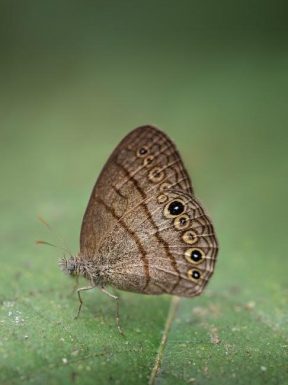Insect egg identification is crucial for understanding life cycles and managing pests effectively. Eggs vary widely in shape, size, and color, reflecting species diversity. This guide helps recognize common insect eggs in the USA, aiding in pest control and ecological balance.
Overview of Insect Eggs and Their Importance
Insect eggs are the starting point of an insect’s life cycle, varying greatly in shape, size, and color. They are often tiny, ranging from microscopic to a few millimeters in size, and can be found in diverse locations such as leaves, soil, or plant stems. The importance of insect eggs lies in their role as the foundation of future generations, influencing both ecosystems and agricultural productivity.
Identifying insect eggs is essential for understanding their life cycles and behaviors. This knowledge aids in pest management, as many harmful insects lay eggs that can lead to infestations. Additionally, recognizing beneficial insect eggs, such as those of ladybugs or butterflies, supports conservation efforts and ecological balance. Thus, insect eggs are a critical focus in both entomology and environmental stewardship.
Why Identifying Insect Eggs is Crucial for Pest Control
Identifying insect eggs is vital for effective pest control, as it allows for early detection of potential infestations. By recognizing egg stages, professionals can implement targeted interventions before pests reach damaging stages. For example, spotting mosquito or house fly eggs in specific habitats enables preemptive measures to prevent their proliferation. Additionally, identifying pest eggs helps in distinguishing harmful species from beneficial ones, ensuring that control methods are applied judiciously. This approach minimizes environmental impact and reduces reliance on broad-spectrum pesticides. Accurate egg identification is therefore a cornerstone of sustainable pest management, protecting both ecosystems and agricultural resources from undue harm.

Understanding Insect Egg Structures
Insect eggs exhibit diverse structures, with variations in shape, size, and surface patterns. The chorion, or eggshell, often features ridges or markings, aiding species identification and adaptation to environments.
Common Shapes and Sizes of Insect Eggs
Insect eggs display remarkable diversity in shape and size, which are crucial for identification. Many species lay oval or spherical eggs, while others produce elongated or cylindrical forms. For example, mosquito eggs are often arranged in raft-like structures and are typically oval-shaped, while butterfly eggs can be spherical or hemispherical. Beetle eggs tend to be elongated, allowing them to fit into narrow crevices. The size of insect eggs also varies significantly, from the tiny, almost microscopic eggs of certain wasps to the relatively large eggs of cockroaches. These variations in shape and size are adaptations to specific habitats and host plants, making them key identifiers in entomological studies.
Color Variations in Insect Eggs
Insect eggs exhibit a wide range of colors, from white and pale yellow to brown and dark shades. These variations serve as vital clues for identification. For instance, whitefly eggs are typically white and found in clusters on leaf undersides, while bed bug eggs are pale and often hidden in cracks. Cockroach eggs, encapsulated in oothecae, may appear brown or reddish. Coloration often helps eggs blend into their surroundings, protecting them from predators. Recognizing these color patterns is essential for accurate identification and can aid in determining whether the eggs belong to pests or beneficial insects. This diversity underscores the complexity of insect life cycles and ecological roles.
Typical Locations Where Insect Eggs Are Laid
Insect eggs are laid in diverse locations, often chosen for protection and food availability. Many species, like whiteflies, deposit their eggs on the undersides of leaves, while others, such as bed bugs, hide theirs in cracks and crevices. Some insects, like ladybugs and praying mantis, lay eggs on plants or stems to ensure their young have access to food upon hatching. Others, such as mosquitoes, prefer aquatic environments, laying eggs near water surfaces. The specific location often correlates with the insect’s life cycle and ecological preferences, making it a key factor in identification and pest management strategies in the USA.
Popular Insects in the USA and Their Eggs
Mosquitoes, house flies, beetles, and moths are common insects in the USA, each laying eggs in specific habitats. Identifying their eggs aids in pest control and biodiversity management.
Mosquito Eggs: Identification and Habitats
Mosquito eggs are slender, white, and typically laid in standing water. They are often found in clusters called “rafts,” which can hatch within 48 hours. Common habitats include stagnant water sources like ponds, bird baths, or even small containers. Identifying these eggs is vital for controlling mosquito populations, as they can transmit diseases such as Zika and West Nile virus. Eliminating standing water and using larvicides are effective management strategies. Recognizing mosquito eggs and their habitats is essential for preventing infestations and reducing public health risks.
House Fly Eggs: Characteristics and Breeding Sites
House fly eggs are small, white, and oval-shaped, typically laid in clusters on decaying organic matter. They hatch within 24 hours into larvae, known as maggots; Common breeding sites include garbage, compost piles, manure, and rotting vegetation. Female house flies prefer moist, nutrient-rich environments for egg-laying, ensuring optimal conditions for larval development. Identifying these eggs and their breeding areas is crucial for effective pest control, as house flies are known to spread diseases. Regular sanitation practices, such as waste management and proper disposal, can significantly reduce house fly populations and prevent infestations.
Beetle Eggs: Distinctive Features and Species Variations
Beetle eggs exhibit remarkable diversity in shape, size, and color, varying significantly across species. Some are cylindrical, while others are spherical or elongated. Colors range from white to yellow or brown, often blending with their surroundings. Female beetles typically lay eggs near food sources, such as plants, wood, or decaying matter. For example, the Colorado potato beetle lays orange eggs on leaf undersides, while the flour beetle deposits white eggs in stored grains; The rice weevil lays eggs inside grain kernels. Understanding these variations aids in identifying pest species and implementing targeted control measures. Accurate identification is essential for managing agricultural and household infestations effectively.
Moth Eggs: Common Types and Their Host Plants
Moth eggs vary in appearance but are often small, spherical, or oval, typically laid on or near host plants. Common types include those of the luna moth, which are green and laid on birch or walnut leaves, and the tent caterpillar moth, whose eggs are brown and clustered on cherry or apple trees. The eggs of the corn borer moth are white and laid on corn leaves. Moth eggs often hatch within a few weeks, and identifying them requires observing their shape, color, and placement on specific plants. This knowledge aids in managing pest species while conserving beneficial moths, many of which are important pollinators.
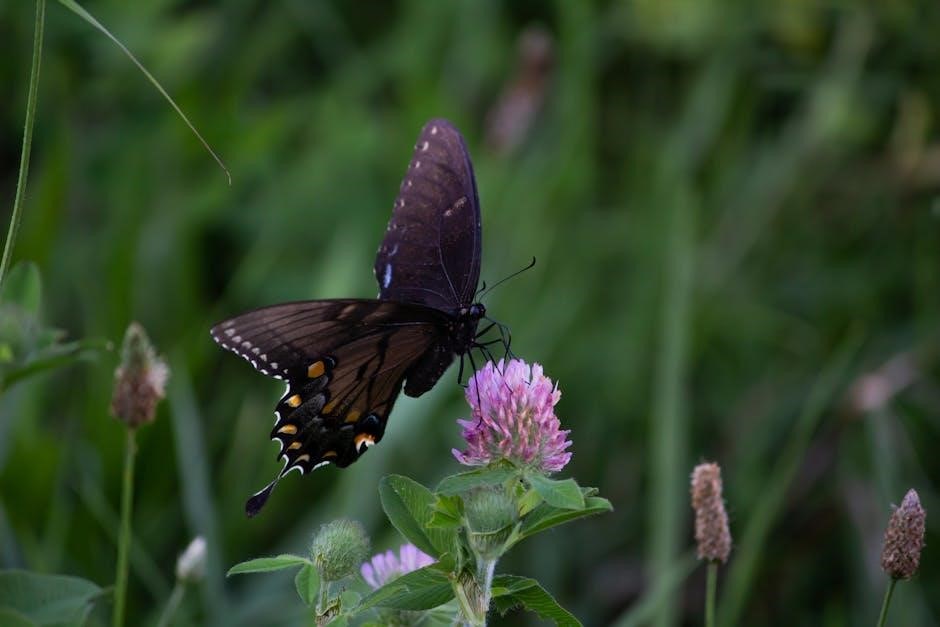
Beneficial Insects and Their Eggs
Beneficial insects like ladybugs, praying mantis, and butterflies lay eggs that are crucial for biological control and maintaining ecosystem balance in gardens and agriculture.
Ladybug Eggs: Identification and Life Cycle
Ladybug eggs are typically yellow, elliptical, and laid in clusters on the underside of leaves. They hatch into larvae, which resemble tiny, legless caterpillars. The life cycle includes four stages: egg, larva, pupa, and adult. Ladybugs are beneficial insects, feeding on aphids and scale insects, making them valuable for biological pest control. Identifying ladybug eggs can help gardeners and farmers recognize these allies early, supporting integrated pest management strategies. Their presence is a positive sign of a balanced ecosystem, and protecting them ensures ongoing pest control benefits.
Praying Mantis Eggs: Unique Characteristics
Praying mantis eggs are protected in a frothy, tan or brown ootheca, often attached to branches or leaves. These structures are large, containing numerous eggs that hatch synchronously; The eggs are typically tan or brown, blending with surroundings for camouflage. Oothecae are essential for protecting eggs from predators and harsh weather. Identifying praying mantis eggs is valuable for biological pest control, as they prey on harmful insects. Recognizing these unique egg cases helps in conserving beneficial species, supporting ecosystem balance and integrated pest management strategies.
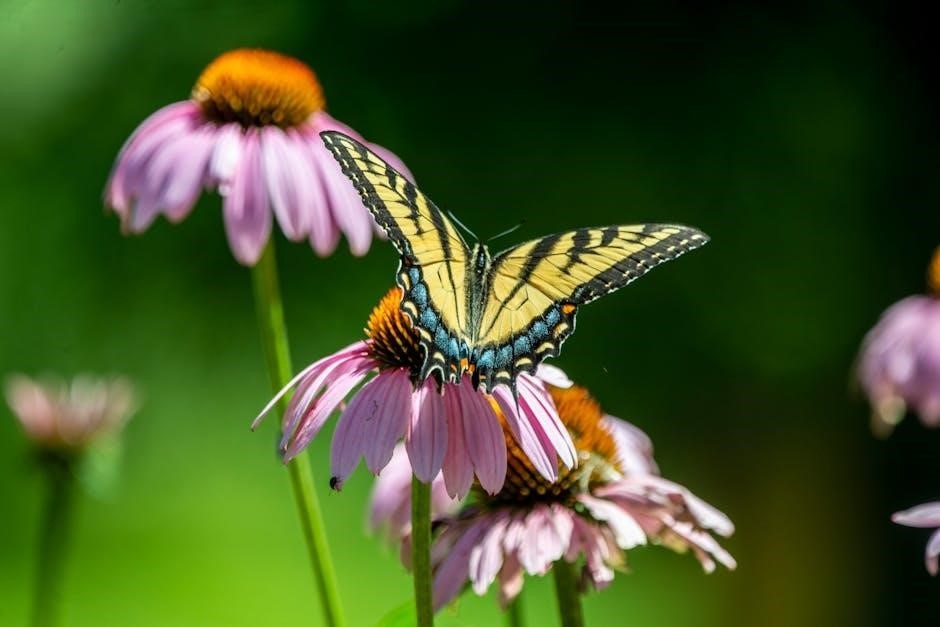
Butterfly Eggs: How to Recognize Them
Butterfly eggs are typically small, ranging in size from 0.1 to 2 millimeters, and vary in shape from spherical to oval or cylindrical. They are often white, yellow, or green, sometimes with intricate patterns. Eggs are usually laid on the underside of leaves, preferably on host plants suitable for caterpillars. Some species, like the monarch butterfly, lay eggs on specific plants like milkweed. Recognition involves examining size, color, and surface texture, as well as the host plant. Using magnification can help identify tiny details. Accurate identification aids in conservation efforts and understanding butterfly life cycles, making it a valuable skill for entomologists and nature enthusiasts alike.
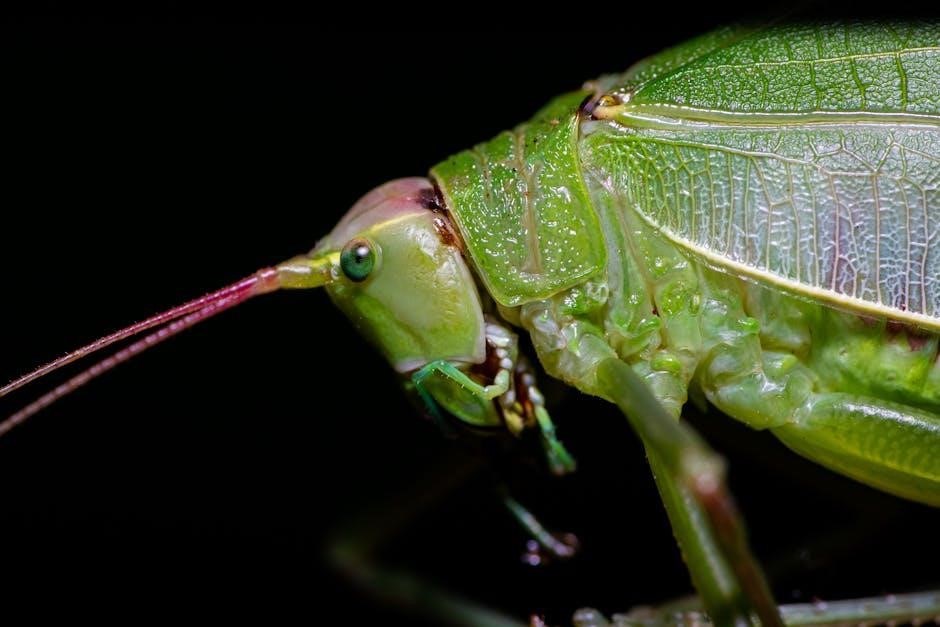
Identifying Insect Eggs by Their Appearance
Insect eggs vary in shape, size, and color, making appearance a key tool for identification. Look for tiny, spherical, or elongated forms, often white, yellow, or brown, and note surface textures or patterns that distinguish species, aiding in quick recognition and classification, especially for pests like whiteflies, bed bugs, or cockroaches.
Whitefly Eggs: Tiny and Often Found on Leaves
Whitefly eggs are incredibly tiny, usually white, and oval-shaped, often laid in clusters on the undersides of leaves. They are commonly found on plants in gardens, greenhouses, and agricultural fields. These eggs are a key sign of whitefly infestations, which can severely damage plants by sucking sap and spreading diseases. Identifying whitefly eggs early is crucial for pest management, as they hatch quickly into nymphs that continue the cycle of damage. Their small size and pale color make them challenging to spot, but knowing their typical locations and appearance can aid in timely detection and control measures to protect crops and ornamental plants.
Bed Bug Eggs: Small and Pale
Bed bug eggs are tiny, pale, and oval-shaped, typically about 1mm long. They are often white or light-colored and laid in cracks, crevices, or near bedding areas. These eggs hatch within a week, making early detection critical for preventing infestations. Bed bug eggs are frequently found in mattresses, box springs, and furniture, especially in homes, hotels, and public places. Identifying them requires careful inspection, as they blend into their surroundings. Their small size and pale color make them challenging to spot, but knowing their typical hiding spots can aid in early detection and effective pest management strategies to control bed bug populations and reduce infestation risks.
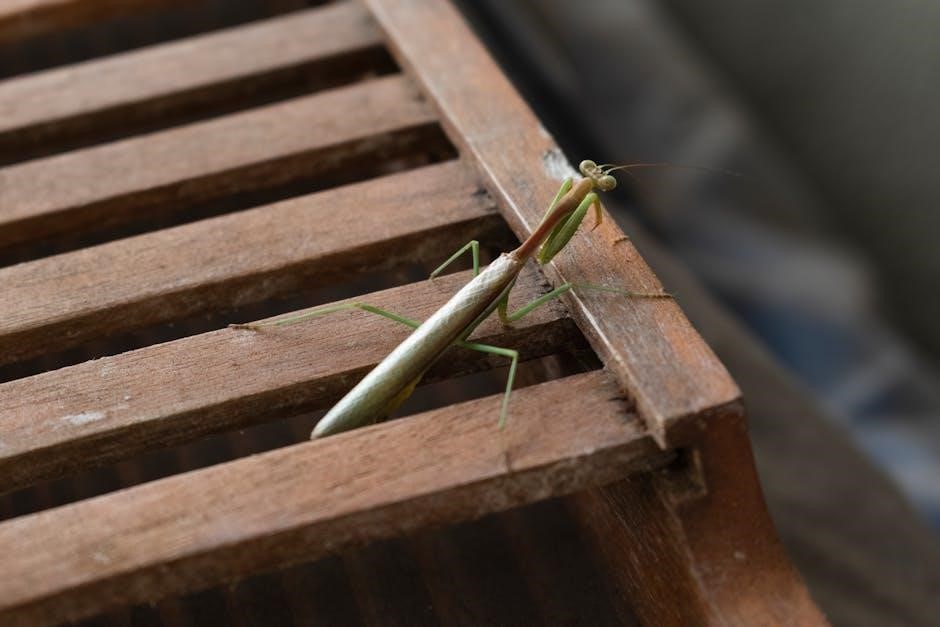
Cockroach Eggs: Oothecae Identification
Cockroach eggs are enclosed in a protective casing called an ootheca, which is typically brown or dark-colored. These structures are elongated and can contain up to 50 eggs, depending on the species. Oothecae are often found in dark, moist areas such as behind appliances, in sewers, or near food sources. They are resilient and can survive in various environments, making them a common pest concern. Identifying cockroach eggs requires looking for these casings, which may be stuck to surfaces or hidden in cracks. Early detection of oothecae is crucial for preventing infestations, as they hatch quickly and can lead to rapid population growth if left unchecked.
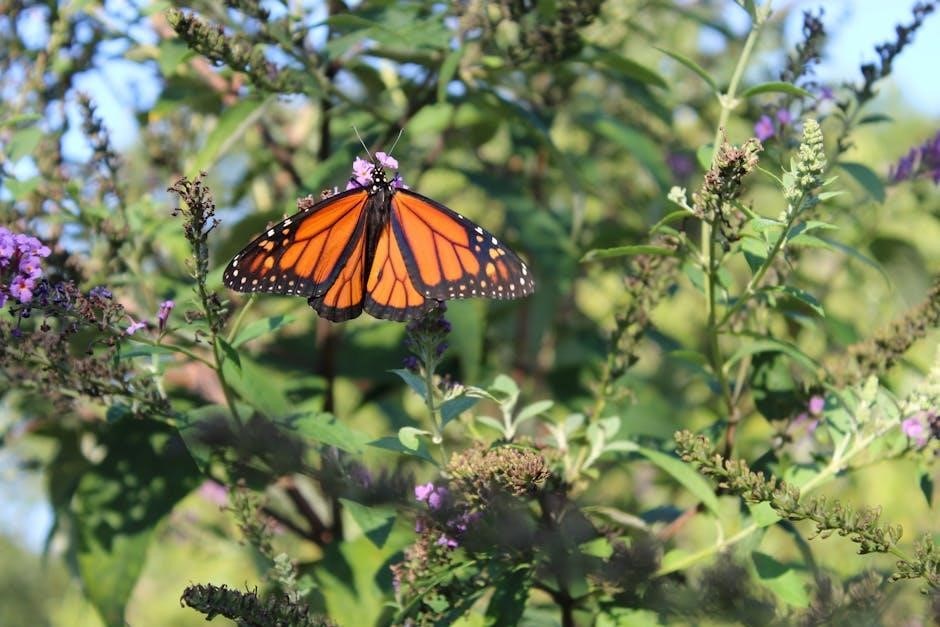
Techniques for Insect Egg Identification
Visual inspection, microscopy, and behavioral observations are key methods for identifying insect eggs. These techniques help determine species, habitat, and life cycle stages accurately in the USA.
Visual Inspection: Key Features to Look For
Visual inspection is a fundamental technique for identifying insect eggs. Key features include shape, size, color, and surface patterns. Eggs can be spherical, oval, or cylindrical, varying in size from microscopic to visible. Colors range from white to dark, often camouflaging with surroundings. Look for distinct patterns like ridges or spikes. The location of eggs—such as on leaves, stems, or soil—is also a critical clue. Tools like hand lenses or magnifying glasses can aid in spotting tiny details. Host plants and egg arrangement (e.g., clustered or solitary) provide further identification clues. This method is essential for quick, non-invasive analysis in pest management and ecological studies.
Using Microscopes for Detailed Analysis
Microscopic examination is essential for precise insect egg identification, especially for tiny or similar-looking species. Stereo microscopes are ideal for observing egg surfaces, while compound microscopes provide higher magnification for intricate details. Key features to examine include eggshell texture, ridges, and embryonic development; Microscopes help distinguish between closely related species and identify parasitized eggs. Professionals often use microscopy to study egg morphology, aiding in accurate classification. Online resources like BugGuide and UC IPM offer microscopic images for comparison. This method is critical for entomologists and pest control specialists, ensuring accurate identification and effective management strategies. Microscopic analysis complements visual inspection, enhancing understanding of insect life cycles and ecological roles.
Behavioral Clues for Egg Identification
Behavioral patterns of insects provide valuable clues for identifying their eggs. Many species exhibit specific oviposition habits, such as laying eggs on particular host plants or in certain environments. For example, mosquitoes often lay eggs in standing water, while butterflies prefer leaves of specific plants. Observing the timing and location of egg-laying can help narrow down species identification. Additionally, the number of eggs and their arrangement (e.g., clustered or singly) offer insights. Understanding these behaviors, combined with visual inspection, enhances accuracy in identifying insect eggs. Resources like BugGuide and UC IPM provide detailed behavioral insights, aiding in precise identification and management strategies for both pests and beneficial insects.
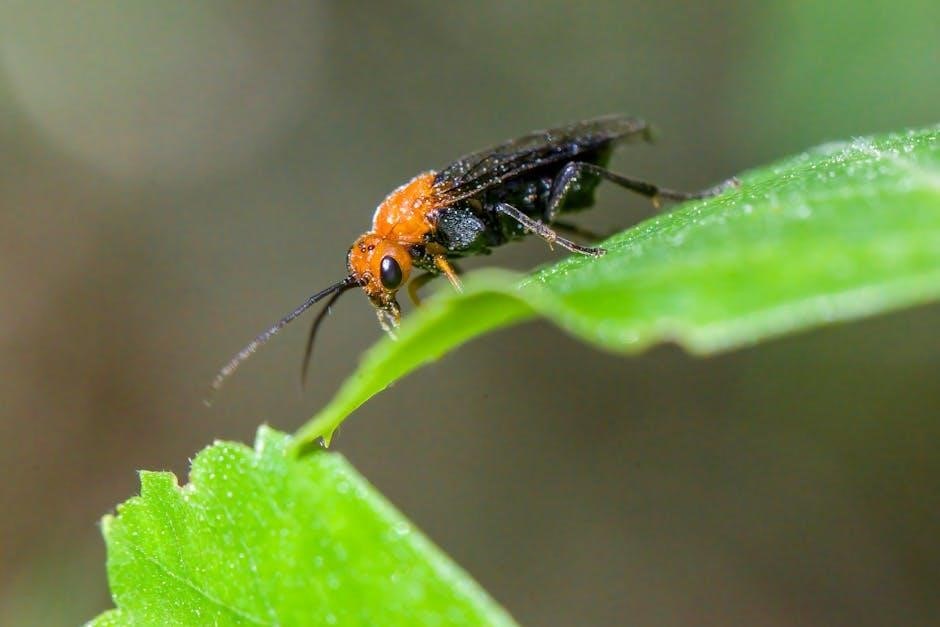
Insect Egg Identification by Region in the USA
Regional variations in insect eggs are influenced by climate and habitat. The Northeast, Southwest, and Midwest each host unique species, requiring tailored identification strategies for effective pest management.
Northeast Region: Common Insect Eggs
The Northeast region of the USA hosts a diverse range of insect eggs due to its temperate climate and abundant vegetation. Common species include whitefly eggs, often found on the undersides of leaves in clusters, and ladybug eggs, which are yellow and oval-shaped, typically laid on plant stems. Moth eggs vary in color but are frequently discovered on host plants like trees or shrubs. Beetle eggs are often laid in soil or plant material, while mosquito eggs are found in standing water. Identifying these eggs is essential for pest management and conservation efforts, as some species can significantly impact agricultural and natural ecosystems.
Southwest Region: Desert-Dwelling Insect Eggs
The Southwest region of the USA, characterized by its arid climate, is home to unique insect eggs adapted to desert conditions. Common species include desert-dwelling beetle eggs, often found in sandy soil or under vegetation. Whitefly eggs are also prevalent, typically laid on the undersides of leaves of desert plants like cacti. Moth eggs are frequently discovered on native plants, while mosquito eggs can be found in standing water, even in ephemeral pools. Identifying these eggs is vital for managing pests and understanding the ecological balance in this fragile environment. The region’s biodiversity supports a variety of insect life cycles, making egg identification a key tool for conservation and pest management efforts.
Midwest Region: Agricultural Pest Eggs
The Midwest, a hub for agriculture, hosts a variety of insect eggs linked to crop pests. Common species include aphid eggs, often found on plant stems, and corn borer eggs, typically laid on leaf undersides. Beetle eggs are also prevalent, with some species targeting specific crops like soybeans. These eggs are usually small, oval, and pale in color, blending into their surroundings. Identifying them early is crucial for preventing infestations and protecting harvests. Farmers and gardeners in the Midwest benefit from recognizing these eggs to implement targeted pest control measures, ensuring agricultural productivity and reducing reliance on broad-spectrum pesticides.

Pest Control and Management
Recognizing pest insect eggs is vital for early intervention and effective control strategies. Common pests like cockroaches and bed bugs lay eggs in hidden, sheltered locations. Identifying these eggs enables targeted treatments, reducing infestations and minimizing pesticide use, promoting sustainable pest management.
How to Recognize Pest Insect Eggs
Recognizing pest insect eggs requires attention to their appearance and habitat. Many pest eggs, like those of mosquitoes and house flies, are tiny, white, and laid in clusters near water or organic matter. Cockroach eggs are enclosed in dark, leathery oothecae, often found in hidden areas. Bed bug eggs are pale, grain-like, and typically discovered in cracks or seams. Beetle eggs may resemble small, oval seeds and are often near food sources. Identifying these eggs early helps prevent infestations, as they indicate potential pest activity. Knowing where to look, such as under leaves or in damp spaces, is key to effective pest management.
Preventive Measures Against Pest Eggs
Preventing pest eggs involves maintaining cleanliness and eliminating habitats. Regularly clean up debris, remove standing water, and seal entry points to deter pests. In gardens, dispose of infested plants and use fine mesh to cover soil. Indoors, vacuum frequently, especially in areas like carpets and upholstery, and store food securely; In agricultural settings, crop rotation and proper sanitation can reduce pest egg presence. Introducing natural predators, like ladybugs, can also help control pest populations. Monitoring plants and surfaces for early signs of eggs ensures timely intervention, preventing infestations before they escalate. Consistent effort is key to minimizing pest egg-related issues effectively.
Organic Methods to Control Insect Eggs
Organic methods offer eco-friendly ways to manage insect eggs. Introduce natural predators like ladybugs or parasitic wasps to prey on pest eggs. Neem oil and diatomaceous earth are effective natural pesticides that disrupt egg development. Horticultural oil applied to infested areas can suffocate eggs. Physical barriers, such as fine mesh, prevent adults from laying eggs on plants. Companion planting with repellent herbs like basil or mint can deter egg-laying insects. Regularly inspecting plants and removing egg clusters manually is another simple yet effective method. These organic strategies promote a balanced ecosystem while avoiding chemical use, making them ideal for sustainable pest management.
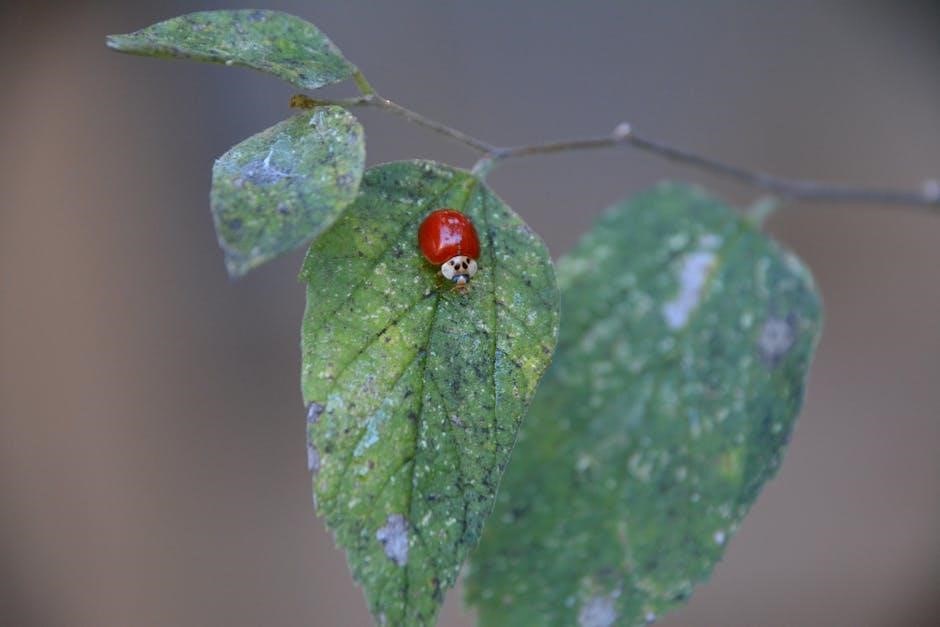
Conservation and Protection
Conservation efforts focus on safeguarding beneficial insect eggs, essential for pollination and pest control. Protecting these eggs ensures ecosystem balance and supports biodiversity in natural habitats.
Protecting Beneficial Insect Eggs
Protecting beneficial insect eggs is vital for maintaining ecological balance. Ladybugs, praying mantis, and butterflies lay eggs that hatch into insects aiding pollination and pest control. Avoiding pesticides and creating habitats with native plants supports these species. Organic gardening practices, such as avoiding chemical sprays, safeguard eggs from harm. Providing sheltered areas for egg-laying sites encourages beneficial insects to thrive. Educating communities about the importance of these eggs fosters conservation efforts. By protecting these eggs, we ensure the survival of beneficial insects, which play a critical role in agriculture and ecosystem health. Their preservation is key to sustainable environments and biodiversity.
The Role of Insect Eggs in Ecosystems
Insect eggs play a vital role in ecosystems, serving as a food source for birds, reptiles, and other insects. They are a crucial link in the food chain, supporting biodiversity. Eggs also indicate environmental health, as their presence reflects habitat quality. Beneficial insects, like ladybugs and parasitic wasps, lay eggs that help control pest populations. In agricultural settings, understanding the role of insect eggs aids in balancing ecosystems and maintaining productivity. Protecting these eggs ensures the survival of species that contribute to pollination, decomposition, and nutrient cycling. Their role in ecosystems highlights the importance of conservation efforts to preserve insect populations and maintain ecological balance.
Insect egg identification aids in ecological balance, pest control, and conservation. Understanding their roles encourages further exploration and sustainable practices in managing ecosystems effectively always.
Identifying insect eggs requires observing their size, shape, and color. Eggs are often laid in specific habitats, such as under leaves or in soil. Using magnification tools like microscopes can reveal detailed features. Behavioral clues, like guarding by parents, also aid identification. Consulting regional guides and agricultural resources helps pinpoint species. Continuous learning and updated references are essential for accurate identification. Recognizing these traits ensures effective pest control and ecological conservation efforts.
Encouragement to Explore Further
Exploring insect egg identification further can deepen your understanding of entomology and ecology. Utilize online resources like BugGuide and agricultural extension services for high-quality images and detailed guides. Engage with local entomological groups to share insights and learn from experts. Observing insect habitats and life cycles firsthand can enhance your identification skills. Remember, every discovery contributes to better pest management and conservation efforts. By continuing to learn, you support both environmental balance and sustainable practices in your community.
